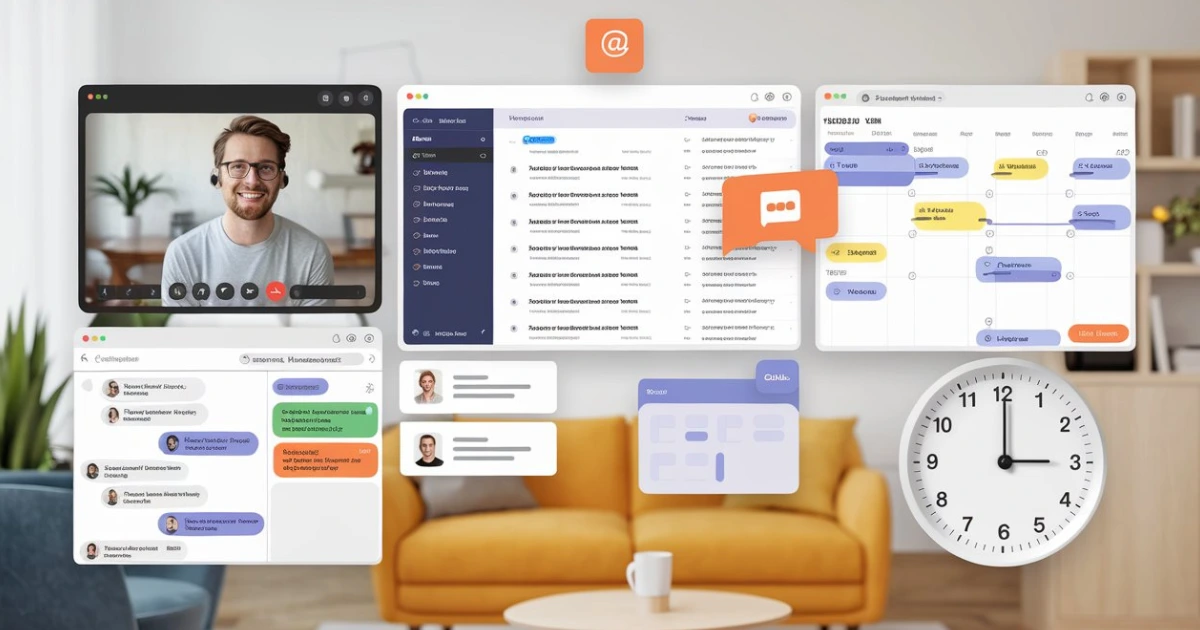Remote Work Tools is changing the way we view our careers because of the recent global events. With more companies embracing a flexible work arrangement, employees will now be able to work from anywhere, thus drastically changing their work-life balance and productivity. However, these are matters solely dependent on the tools used in doing it.

Having the right tools does not only streamline the communication process but also helps in better collaboration among the team members no matter what the locations are. Right from project management software to communication platforms, these tools enable remote workers to organize and function very efficiently. With remote work culture emerging as the norm, we must actually equip ourselves with the best resources to keep things in line and to build further teamwork. Within this blog post, we will explore the must-have tools and software that every remote worker will need to know to grow in the new landscape.
Communication Remote Work Tools
Good communication is the backbone of remote work, and many tools make it easy. Here are three indispensable platforms that help with communication, which every remote worker should look at:
Slack
With Slack, it is the perfect real-time messaging tool by which teams can easily communicate across to a varying degree. The platform is channel-based but users can place different channels for a project, department, or even on a topic that will be easier to organize conversations and information is accessible at all times. Slack also allows file sharing and direct messaging for quick exchange of ideas and valuable resources. Further, the app supports integration with other apps like Google Drive and Trello, thereby making collaboration is made more fluid.
Zoom
Zoom is one of the go-to video conferencing and virtual meeting platforms for face-to-face interactions. In fact, the interface allows you to easily schedule and join meetings, and features like screen sharing and breakout rooms can help make you effective in your collaboration endeavors. Whether you have a catch-up one-on-one or a massive team meeting, rest assured that you would get clear communication using its excellent video and audio quality. Moreover, recording teams can look back at the pertinent discussions and share insights with participants who have missed the meeting.
Microsoft Teams
Microsoft Teams integrates communication and collaboration in a single app. For any company already using the suite of products found in Microsoft’s Office, Teams is highly scalable for their use cases. Among the various functions accomplished in real-time are chat, video conferencing, and file sharing by team members. Dedicated channels for specific projects by teams help organize task-related discussions and keep track of them. With robust integration with Microsoft 365, access to documents is directly accessible within the app to streamline work applications and enhance productivity.
Through these communications, remote employees are able to relate well and develop rapport with their teams, ensuring that collaboration continues to be efficient and effective regardless of where an employee is stationed.
Project Management Tools
Even the most simple project would quickly devolve into incoherence and overwhelm when being managed by a remote team, not to mention if the management is not effective. Therefore, some of the top tools that should be considered to streamline workflow and enhance productivity include the following:
Trello
Trello makes managing tasks appear beautiful and pleasing. It’s achieved through the board-and-card system, wherein users can create boards representing different projects. The boards have the cards, which are nothing but individual tasks. All these cards are easily moved between other columns for example “To Do,” “In Progress,” and “Done,” thereby giving a clear visual indication of progress. One feature with Trello is the ability to personalize your boards with the use of labels, due dates, and checklists that makes it easy to prioritize tasks and effectively collaborate. Communications and efficiency are made easier with integrations from other tools such as Slack and Google Drive.
Asana
Being a task-tracking and project-planning application, Asana proves to be very handy for those teams that insist on keeping things organized within their workflow. Users can create projects, assign tasks, set deadlines, and track everything in one place. The timeline view in Asana makes available a Gantt chart-style visual presentation of the milestones within the project so the teams can visualize deadlines and dependencies. Moreover, the system has various templates particularly for different industries so that setting up projects becomes easy. Asana’s robust reporting tools enable managers to view the performance of teams and project health to ensure that everyone is on the same page about goals.
ClickUp
An all-in-one solution, ClickUp is all about integrating task management, docs, goals, and time tracking all in one platform. Its interface is highly customizable to enable teams to tailor workflows according to particular needs through lists, boards, or calendars. Its automation capabilities will help minimize repetitive tasks and let you get things done more efficiently. Also, features like goal tracking and detailed reporting are important for measuring performance and keeping everyone focused on results. Connections to many applications, including Slack and Zoom, are also handy to consolidate all aspects of your workflow.
With all these management tools in a project, remote teams can expand team collaboration, and manage their projects effectively towards shared goals.
File Sharing and Collaboration
The first essential value of an effective file sharing and collaborative tool in a remote work environment is team productivity. Among the following three top tools that enable document management and collaboration are:

Google Drive
Google Drive is a popular cloud application providing storage, along with the features of document collaboration. There can be upload and sharing of files and then accessed by collaborators towards real-time documents. With real-time integration of Google Docs, Sheets, and Slides into the tool, the team will be able to edit documents simultaneously while leaving comments and suggestions for each other. The intuitive and user-friendly interface and the ease of access make Google Drive suitable for teams who want to streamline workflow and enhance collaboration in brainstorming sessions as well as planning projects.
Dropbox
Another useful file-sharing tool is Dropbox. It is mainly known as a very simple yet reliable tool. This is also very user-friendly, because a user can upload files to his Dropbox account and share it with team members or clients through links or direct invitations. Synchronization abilities also ensure that files will be updated automatically across all the devices so that users are able to get the latest versions anytime, anyplace. Dropbox also provides a feature or facility of file recovery and version history to give peace of mind for the person working on critical projects. Dropbox is pretty easy to insert into most workflows owing to most other productivity app integrations.
Microsoft OneDrive
OneDrive is a file storage service offered by Microsoft. The integration with the Microsoft Office applications makes for convenient saving of the documents directly to OneDrive and access as well as sharing of files stored online. The team can develop Word, Excel, and PowerPoint documents in real-time, thus improving teamwork and boosting productivity. OneDrive also boasts quite powerful security capabilities, such as data encryption and file access controls, to safeguard confidential information. As a part of the Microsoft 365 suite, OneDrive will be a good option for organizations that already apply Microsoft products, thus making their workflow more integrated and smooth.
These file-sharing and collaboration tools will help remote teams work better together so that they can all gain access to the resources needed to make valuable contributions.
Time Management Tools
Important time management for the remote worker to maximize output while keeping on top of work-life balance. Here are three effective time management tools that help you track your time and optimize your workflow:
Toggl
It is the popular time tracking tool that has been designed for simplicity and efficiency. With such an intuitive user interface, you can start and stop timers over any tasks you are working on in the course of the day so that you can get an actual picture of how you spend your time. Toggl really has been perfect at reporting features so that you might be able to see exactly which patterns of productivity you need to observe, which tasks eat most of your time, and where you might improve. The tool also assimilates different project management apps, making it very easy to align tracked time with active projects. Toggl has allowed mobile applications that track time anywhere and at any time, bringing out absolute flexibility.
Clockify
Clockify is a free time tracking tool that can be used individually as well as on a team basis. Its very simple time tracking system helps in logging hours spent on specific tasks and projects, bringing out easy monitoring of productivity. Clockify also provides more detailed reporting and dashboard capabilities for the easy visualization of time consumed and performance over days, weeks, or months. The tool supports multiple projects and clients ideal for freelancers and those that work on various assignments. The browser extension and mobile app also ensure that tracking times is convenient and accessible.
RescueTime
RescueTime tracks time use but goes beyond that and offers an analysis of how much time is spent on different applications and sites. It runs in the background automatically to record activities and productivity levels. Reports detail which aspects of work take up the most amounts of time, helping focus attention on the areas being diverted. RescueTime offers functionalities such as goal setting and alerts to keep one motivated towards what’s important. With this consciousness, a telecommuter can make informed decisions on how to enhance productivity and develop a better work-life balance.
With these time management tools, a telecommuter can benefit from an understanding of productivity that allows him to work more intelligently and much more effectively at achieving his objectives .
Virtual Whiteboards and Brainstorming Tools
Effect brainstorming and collaboration are quite critical as far as this remote setting is concerned to generate innovative ideas. Virtual whiteboards and brainstorming tools ease creative processes by allowing teams to visualize concepts at hand while working together seamlessly. There are three standout options:
Miro
Miro is a versatile collaborative online whiteboard that does well, especially in brainstorming sessions and workshops. It offers an expansive canvas on which teams can create diagrams, mind maps, or flowcharts in real-time. Miro’s friendly interface allows for easy drag-and-drop functionality, which enables team members to add notes, images, and media. Miro templates for agile workflows, user feedback tools, and popular apps’ integrations, such as Slack and Zoom can elevate teamwork and creativity. From product development to strategy planning, it is an invaluable process in getting teams engaged in Miro.
MURAL
MURAL is another very powerful visual collaboration tool, which is designed to be the tool teams use for brainstorming and innovating with each other. Like Miro, it allows a common digital space where users can sketch, plan, or even organize their ideas. It offers a rich library of templates toward different activities-from design thinking to retrospectives. MURAL also offers voting and commenting for effective group decision-making and feedback. The visual communication on the platform enables teams to connect ideas and streamline discussions; therefore, it’s ideal for remote workshops and collaborative projects.
Jamboard
Jamboard is an interactive whiteboard by Google integrated with Google Workspace. Therefore, it is ideal for those teams working in Google. One can create and collaborate on a digital canvas in real-time within Jamboard with features such as sticky notes, drawings, and image uploads. It has a very intuitive interface so that team members can engage easily in contributing ideas visually, ensuring that all brainstorming sessions are easily accessible to the teams, saving their work and re-accessing it. This is particularly effective for creative sessions and project kick-offs.
Using virtual whiteboards and brainstorming tools improves the collaboration of teams, while their physical location does not come into play.
Cybersecurity Tools
In this era where most people deem it very crucial to do their jobs remotely, it becomes even more important to secure one’s cybersecurity. Given the fact that employees access sensitive information from multiple locations, it necessitates remote workers to be efficient with regard to cybersecurity tools that guard their information. Here are three salient tools that will safeguard your digital environment.
LastPass
This is one of the leading password management tools, so one can easily access multiple accounts securely. This has made the necessity of unique and complicated passwords inevitable for every single service one uses online. LastPass generate secure passwords and saves them safely in an encrypted vault. Users do not need to remember each one because LastPass allows them to access it on any of their devices. In addition, LastPass offers password sharing for teams, security alerts when accounts are compromised, and a two-factor authentication layer of protection. With LastPass, remote workers minimize the possibilities for unauthorized access to accounts. Thus, it prevents unauthorized access to sensitive information.
NordVPN
An encrypted Virtual Private Network from NordVPN conceals your actual IP address while encrypting all your internet traffic. Quite a number of remote workers use public Wi-Fi in most cases. Thus, their networks are an easy target for cyber attacks. Apart from that, you will browse the internet anonymously safely with NordVPN, and you won’t have to worry about hackers intercepting your data. Among many other features, NordVPN offers a kill switch in case the VPN fails, ad-blocking capabilities so that you can enjoy browsing more overall. By having servers in so many countries, NordVPN is useful for remote workers in order to gain access to geo-restricted content.
Antivirus Software
Any security strategy cannot be considered comprehensive without the necessary antivirus software. This is because it is the protection against malware, viruses, and more forms of cyber attacks that would compromise sensitive information. A strong antivirus solution goes beyond the scanning and removal of harmful software but provides real-time protection for emerging threats. With all features, including firewall protection, email scanning, and tools for safe browsing, it is a sure way to diminish risks to oneself while working online. Keeping the software updated will also ensure that the threats of today will be covered, hence requiring the remote worker to have a good antivirus program. Users must maintain proper antivirus protection to prevent potential cyber threats to their computing devices and personal data.
In a nutshell, for remote workers, using tools like LastPass, NordVPN, and antivirus software would be of great importance in maintaining a secure digital environment. Cybersecurity as a priority enables people to have safe entry into their sensitive information, ensuring safe and productive remote work.
Productivity Tools
Staying productive at home is not easy, but sometimes, the right tool can really help. Here are three very useful tools that help a person be organized and focused to do work on time:

Notion
Notion enables users to attach notes, tasks, and databases in an all-in-one workspace; it’s a versatile tool for remote workers. Therefore, it lets users create customized pages on how to organize their projects and ideas and documentation in an easy-to-view manner. Notion provides an easy layout in which you can add text, images, tables, and even calendars in order to fully handle projects. You can facilitate collaboration among team members through features that enable them to share pages, comment, and contribute in real time. Therefore, Notion is great for group projects. Templates are offered for different use cases-from simple to-do lists to project trackers-making it suitable for different needs for productivity.
Evernote
Evernote is a robust note-taking app designed for capturing users’ thoughts efficiently. All features such as image text recognition, web clipping, or tagging of notes to make them accessible with ease help in keeping the important information within your fingertips. A notebook can be created to categorize the notes set within reminders for tracking deadlines. It makes jotting down ideas convenient while working on a task with uninterrupted access across devices. With many projects on the go, remote workers need a reliable digital filing cabinet that does not let things fall between the cracks, and Evernote is the perfect fit for this.
Todoist
Todoist is one of the best tools for managing tasks, allowing the users to prioritize and make their to-do lists more effective by managing them. Using its user-friendly interface, users can set up tasks, fix deadlines, and arrange them into certain projects. Thanks to the reminders feature of the app, important deadlines will never slip from the mind. Todoist offers the facility to use powerful filtering and labeling techniques that help sort various tasks according to a user’s needs, making the chance high for him to do the most important. The karma system monitors what kind of productivity he has generated and shows him encouragement to complete his tasks to keep his streak going. Being available on multiple platforms, Todoist helps remote workers stay organized and on top of their responsibilities which makes for a more productive work environment.
Indeed, handling time on the job or in different working locations is feasible and definitely possible if tools like Notion, Evernote, and Todoist are integrated into daily operations.
Conclusion
Productivity within the virtual working environment of today can’t be effectively sustained without the necessary tools. From a communication perspective, Slack and Zoom to Trello and Asana, which are project management tools, ensure perfect interaction among the employees. There are also file-sharing services such as Google Drive and Dropbox, and time management tools including Toggl and Clockify, keeping everyone connected and productive simultaneously.
They guard sensitive information in the forms of cybersecurity tools like LastPass and NordVPN, while others, such as Notion and Todoist, help me keep an organized focus on productivity applications.
This means discovery of these tools and use of those best for you, according to your needs, workflow, and the rest. Each of them has unique functions meant to enhance your productivity and cooperation, making this remote work experience efficient and enjoyable. Welcome these resources and take them as instruments for making the most of this developing workplace.
Call to Action
We would love to hear your choices! It is a communication platform, an application for project management, or maybe just a tracking tool as your input may make that solution useful for someone to get the one enriching their productivity and collaboration. Share your top pick in the comments below!
Additionally, if you find creative ways in which you can use the software or some life hacks that will make life easier while remote working, do share them too. Many remote workers want the experience from fellow remote workers by optimizing workflows.
As remote work continues to evolve, keeping current with the best tools and practices will remain crucial. It’s in all our best interests to share what we learn and benefit from other people’s collective experiences in how to make remote work more efficient and enjoyable. Don’t wait; join the conversation and tell us what works! In making these community resource builders-thrive-in the world of remote work, that’s all together.
FAQs
- What are the major tools of working remotely?
The most important tools of remote work are communication tools like Slack and Zoom, project management tools, among those, lists include Trello and Asana, file-sharing services such as Google Drive and Dropbox, and time management apps such as Toggl and Clockify.
- How to secure my setup while working remotely?
For security purposes, take advantage of products that include password management via LastPass, safe browsing on the internet with the help of NordVPN, and even good antivirus security to avoid malware and cyber attacks.
- Which productivity tools can help me stay organized?
Most recommended, necessary tools that ensure productive work include: Notion, Evernote, and Todoist. These tools will focus on note-taking, task management, and your general organization in a very straightforward way.
- Are there free tools for remote work?
Many free versions of effective remote work tools are available; for instance, Slack, Trello, Clockify, or Google Drive may be used in the pocket of even a small-budget individual or team.
- How do you choose the right tools for your needs?
Most important would be to consider the specifics of your work, the size of your team, and your projects’ nature. You must research many tools, utilize free trial periods, and ask around for your team’s feedback to find one best suited to your workflow.
- How do I get my team to adapt to the new tools?
Introduce the new tools gradually, and give training sessions to explain to the teams how they facilitate the exchange of information and increase productivity in terms of collaboration. Seek constant feedback and be open to changing and adjusting based on the team’s feedback.







